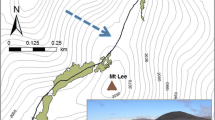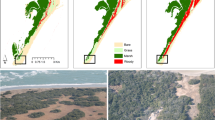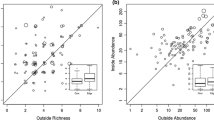Abstract
Shrub expansion has occurred across much of the arctic tundra over the past century. Increasing dominance of woody vegetation is expected to have global influences on climate patterns and lead to local changes in hydrological function and nutrient cycling. Changing abiotic conditions associated with shrubs will likely alter the relative fitness of neighbouring plants resulting in distinct community composition. Here, we use an extensive set of paired abiotic and biotic data to investigate the capacity for Alnus alnobetula (green alder) patches to modify the habitat of the local plant community at the taiga–tundra ecotone of the Northwest Territories, Canada. Plots were established across topographic positions in ten alder patches and adjacent, alder-free tundra. Habitat corresponded to the strongest gradient of among-site variation in abiotic measures and plant community composition, indicating that alder patch growing conditions were distinct from those of alder-free tundra. Slope position was generally unimportant in determining environmental conditions. Alder patches changed the vertical structure of the understory by increasing the maximum height of birch. Tall shrubs also decreased the richness of tundra specialists, suggesting that these species face competitive pressures from shrub expansion at the southern edge of their ranges. Our findings demonstrate that tall shrub patches can substantially modify their local environment in taiga–tundra ecotone systems, altering available habitat and acting as niche constructors for the local plant community. These habitats will therefore be important to consider in regional predictions of hydrology, nutrient cycling, and biodiversity as shrubs continue to expand across the arctic.





Similar content being viewed by others
References
Aiken SG, Dallwitz MJ, Consaul LL, McJannet CL, Boles RL, Argus GW, Gillett JM, Scott PJ, Elven R, LeBlanc MC, Gillespie LJ, Brysting AK, Solstad H, Harris JG. 2007. Flora of the Canadian Arctic Archipelago: descriptions, illustrations, identification, and information retrieval. NRC Research Press, National Research Council of Canada, Ottawa. http://nature.ca/aaflora/data. Accessed on September 8, 2018.
Bates D, Maechler M, Bolker B, Walker S. 2015. Fitting linear mixed-effects models using lme4. J Stat Softw 67:1–48. https://doi.org/10.18637/jss.v067.i01.
Berg B, Staaf H. 1980. Decomposition rate and chemical changes of Scots pine needle litter. II. Influence of chemical composition. Ecol Bull 32:373–90.
Billings W. 1987. Constraints to plant growth, reproduction, and establishment in arctic environments. Arct Alp Res 19:357–65.
Blok D, Heijmans MMPD, Schaepman-Strub G, Kononov AV, Maximov TC, Berendse F. 2010. Shrub expansion may reduce summer permafrost thaw in Siberian tundra. Glob Change Biol 16:1296–305. https://doi.org/10.1111/j.1365-2486.2009.02110.x.
Blok D, Weijers S, Welker JM, Cooper EJ, Michelsen A, Löffler J, Elberling B. 2015. Deepened winter snow increases stem growth and alters stem δ13 C and δ15 N in evergreen dwarf shrub Cassiope tetragona in high-arctic Svalbard tundra. Environ Res Lett 10:1–14. https://doi.org/10.1088/1748-9326/10/4/044008.
Bråthen KA, Ravolainen VT. 2015. Niche construction by growth forms is as strong a predictor of species diversity as environmental gradients. J Ecol 103:701–13. https://doi.org/10.1111/1365-2745.12380.
Bret-Harte MS, Shaver GR, Zoerner JP, Johnstone JF, Wagner JL, Chavez AS, Gunkelman RFIV, Lippert SC, Laundre JA. 2001. Developmental plasticity allows Betula nana to dominate tundra subjected to an altered environment. Ecology 82:18–32. https://doi.org/10.1890/0012-9658(2001)082[0018:DPABNT]2.0.CO;2.
Buckeridge K, Zufelt E, Chu H, Grogan P. 2010. Soil nitrogen cycling rates in low arctic shrub tundra are enhanced by litter feedbacks. Plant Soil 330:407–21.
Bühlmann T, Körner C, Hiltbrunner E. 2016. Shrub expansion of Alnus viridis drives former montane grassland into nitrogen saturation. Ecosystems 19:968–85. https://doi.org/10.1007/s10021-016-9979-9.
Chapin FS, Shaver G, Giblin A, Nadelhoffer KJ, Laundre JA. 1995. Responses of arctic tundra to experimental and observed changes in climate. Ecology 76:694–711.
Christiansen CT, Lafreniére MJ, Henry GHR, Grogan P. 2018. Long-term deepened snow promotes tundra evergreen shrub growth and summertime ecosystem net CO2 gain but reduces soil carbon and nutrient pools. Glob Change Biol . https://doi.org/10.1111/gcb.14084.
Cody W. 2000. Flora of the Yukon Territory. 2nd edn. Ottawa: NRC Research Press.
Cornelissen JHC, Van Bodegom PM, Aerts R, Callaghan TV, van Logtestijn RSP, Alatalo J, Stuart Chapin F, Gerdol R, Gudmundsson J, Gwynn-Jones D, Hartley AE, M.O.L. Team. 2007. Global negative vegetation feedback to climate warming responses of leaf litter decomposition rates in cold biomes. Ecol Lett 10:619–27. https://doi.org/10.1111/j.1461-0248.2007.01051.x.
Densmore RV. 2005. Succession on subalpine placer mine spoil: effects of revegetation with Alnus viridis, Alaska, U.S.A. Arct Antarct Alp Res 37:297–303. https://doi.org/10.1657/1523-0430(2005)037[0297:SOSPMS]2.0.CO;2.
Endrizzi S, Quinton WL, Marsh P. 2011. Modelling the spatial pattern of ground thaw in a small basin in the arctic tundra. Cryosphere Discus 5:367–400. https://doi.org/10.5194/tcd-5-367-2011.
Elmendorf SC, Henry GHR, Hollister RD, Björk RG, Bjorkman AD, Callaghan TV, Collier LS, Cooper EJ, Cornelissen JH, Day TA, Fosaa AM, Gould WA, Grétarsdóttir J, Harte J, Hermanutz L, Hik DS, Hofgaard A, Jarrad F, Jónsdóttir IS, Keuper F, Klanderud K, Klein JA, Koh S, Kudo G, Lang SI, Loewen V, May JL, Mercado J, Michelsen A, Molau U, Myers-Smith IH, Oberbauer SF, Pieper S, Post E, Rixen C, Robinson CH, Schmidt NM, Shaver GR, Stenström A, Tolvanen A, Totland O, Troxler T, Wahren CH, Webber PJ, Welker JM, Wookey PA. 2012. Global assessment of experimental climate warming on tundra vegetation: heterogeneity over space and time. Ecol Lett 15:164–75. https://doi.org/10.1111/j.1461-0248.2011.01716.x.
Euskirchen ES, Bennett AP, Breen AL, Genet H, Lindgren MA, Kurkowski TA, McGuire AD, Rupp TS. 2016. Consequences of changes in vegetation and snow cover for climate feedbacks in Alaska and northwest Canada. Environ Res Lett 11:105003. https://doi.org/10.1088/1748-9326/11/10/105003.
Flora of North America Editorial Committee, eds. 1993 + . Flora of North America North of Mexico. 20+ vols. New York and Oxford.
Fox J, Weisberg S. 2011. An R companion to applied regression, Second Ediition. Thousand Oaks, CA: Sage.
Gill HK, Lantz TC, Neill BO, Kokelj SV. 2014. Cumulative impacts and feedbacks of a gravel road on shrub tundra ecosystems in the Peel Plateau, Northwest Territories, Canada. Arct Antarct Alp Res 46:947–61.
Giardina C, Huffman S, Binkley D, Caldwel B. 1995. Alders increase soil phosphorus availability in a Douglas-fir plantation. Can J For Res 25(10):1652–7.
Hiltbrunner E, Aerts R, Bühlmann T, Huss-Danell K, Magnusson B, Myrold DD, Reed SC, Sigurdsson BD, Körner C. 2014. Ecological consequences of the expansion of N2-fixing plants in cold biomes. Oecologia 176:11–24. https://doi.org/10.1007/s00442-014-2991-x.
Hobbie S. 1996. Temperature and plant species control over litter decomposition in Alaskan tundra. Ecol Monogr 66(4):503–22.
Hothorn T, Bretz F, Westfall P. 2008. Simultaneous inference in general parametric models. Biom J 50:346–63.
Johnson D, Kershaw L, MacKinnon A. 2009. Plants of the Western Forest; Alberta Saskatchewan and Manitoba Boreal and Aspen Parkland. Edmonton: Lone Pine Publishing.
Jonasson S. 1983. Nutrient content and dynamics in north Swedish shrub tundra areas. Holarct Ecol 6:295–304.
Keuskamp JA, Dingemans BJJ, Lehtinen T, Sarneel JM, Hefting MM. 2013. Tea Bag Index: a novel approach to collect uniform decomposition data across ecosystems. Methods Ecol Evol 4:1070–5. https://doi.org/10.1111/2041-210X.12097.
King D. 1990. The adaptive significance of tree height. Am Nat 135:809–28.
Kuznetsova A, Brockhoff P, Bojesen R. 2016. lmerTest: tests in linear mixed effects models. R package version 2.0-33. https://CRAN.R-project.org/package=lmerTest.
Lantz TC, Gergel SE, Henry GHR. 2010. Response of green alder (Alnus viridis subsp. fruticosa) patch dynamics and plant community composition to fire and regional temperature in north-western Canada. J Biogeogr 37:1597–610. https://doi.org/10.1111/j.1365-2699.2010.02317.x.
Lantz TC, Marsh P, Kokelj SV. 2013. Recent shrub proliferation in the Mackenzie Delta uplands and microclimatic implications. Ecosystems 16:47–59. https://doi.org/10.1007/s10021-012-9595-2.
Lawrence DM, Swenson SC. 2011. Permafrost response to increasing Arctic shrub abundance depends on the relative influence of shrubs on local soil cooling versus large-scale climate warming. Environ Res Lett 6:045504. https://doi.org/10.1088/1748-9326/6/4/045504.
Le S, Josse J, Husson F. 2008. FactoMineR: an R package for multivariate analysis. J Stat Softw 25:1–18. https://doi.org/10.18637/jss.v025.i01.
Lütz C. 2010. Cell physiology of plants growing in cold environments. Protoplasma 244:53–73. https://doi.org/10.1007/s00709-010-0161-5.
Marsh P, Bartlett P, MacKay M, Pohl S, Lantz T. 2010. Snowmelt energetics at a shrub tundra site in the western Canadian Arctic. Hydrol Process 24(25):3603–20.
McNickle GG, Lamb EG, Lavender M, Cahill JF, Schamp BS, Siciliano SD, Condit R, Hubbell SP, Baltzer JL. 2018. Checkerboard score-area relationships reveal spatial scales of plant community structure. Oikos 127:415–26. https://doi.org/10.1111/oik.04620.
Moffat ND, Lantz TC, Fraser RH, Olthof I. 2016. Recent vegetation change (1980–2013) in the tundra ecosystems of the Tuktoyaktuk Coastlands, NWT, Canada. Arct Antarct Alp Res 48:581–97. https://doi.org/10.1657/AAAR0015-063.
Myers-Smith IH, Forbes BC, Wilmking M, Hallinger M, Lantz T, Blok D, Tape KD, Macias-Fauria M, Sass-Klaassen U, Lévesque E, Boudreau S, Ropars P, Hermanutz L, Trant A, Siegwart Collier L, Weijers S, Rozema J, Rayback SA, Schmidt NM, Schaepman-Strub G, Wipf S, Rixen C, Ménard CB, Venn S, Goetz S, Andreu-Hyles L, Elmensdorf S, Ravolainen V, Welker J, Grogan P, Epstein HE, Hik DS. 2011. Shrub expansion in tundra ecosystems: dynamics, impacts and research priorities. Environ Res Lett 6:045509. https://doi.org/10.1088/1748-9326/6/4/045509.
Myers-Smith IH, Elmendorf SC, Beck PSA, Wilmking M, Hallinger M, Blok D, Tape KD, Rayback SA, Macias-Fauria M, Forbes BC, Speed JDM, Boulanger-Lapointe N, Rixen C, Lévesque E, Schmidt NM, Baittinger C, Trant AJ, Hermanutz L, Collier LS, Dawes MA, Lantz TC, Weijers S, JØrgensen RH, Buchwal A, Buras A, Naito AT, Ravolainen V, Schaepman-Strub G, Wheeler JA, Wipf S, Guay KC, Hik DS, Vellend M. 2015. Climate sensitivity of shrub growth across the tundra biome. Nat Clim Change 5:887–91. https://doi.org/10.1038/nclimate2697.
Naito AT, Cairns DM. 2011. Relationships between Arctic shrub dynamics and topographically derived hydrologic characteristics. Environ Res Lett 6:1–8. https://doi.org/10.1088/1748-9326/6/4/045506.
Oksanen J, Blanchet F, Friendly M, Kindt R, Legendre P, McGlinn D, Minchin PR, O’Hara RB, Simpson GL, Solymos P, Henry M, Stevens H, Szoecs E, Wagner H. 2017. vegan: Community Ecology Package. R package version 2.4-3. https://CRAN.R-project.org/package=vegan.
Porslid A, Cody W. 1980. Vascular plants of Continental Northwest Territories, Canada. Ottawa: National Museum of Natural Sciences.
R Core Team. 2017. R: a language and environment for statistical computing. R Foundation for Statistical Computing. http://www.r-project.org/. Vienna, Austria.
Ropars P, Lévesque E, Boudreau S. 2015. Shrub densification heterogeneity in subarctic regions: the relative influence of historical and topographic variables. Écoscience 22:1–13. https://doi.org/10.1080/11956860.2015.1107262.
Schimel JP, Bilbrough C, Welker JM. 2004. Increased snow depth affects microbial activity and nitrogen mineralization in two Arctic tundra communities. Soil Biol and Biochem 36:217–27. https://doi.org/10.1016/j.soilbio.2003.09.008.
Starr G, Oberbauer SF. 2003. Photosynthesis of arctic evergreens under snow: implications for tundra ecosystems. Ecology 84:1415–20. https://doi.org/10.1890/02-3154.
Sturm M. 2005. Changing snow and shrub conditions affect albedo with global implications. J Geophys Res . https://doi.org/10.1029/2005JG000013.
Sturm M, McFadden J, Liston GE, Chapin FS, Racine CH, Holmgren J. 2001. Snow-shrub interactions in Arctic tundra: a hypothesis with climatic implications. J Clim 14:336–44.
Swann AL, Fung IY, Levis S, Bonan GB, Doney SC. 2010. Changes in Arctic vegetation amplify high-latitude warming through the greenhouse effect. Proc Natl Acad of Sci U S A 107:1295–300. https://doi.org/10.1073/pnas.0913846107.
Tape K, Sturm M, Racine C. 2006. The evidence for shrub expansion in Northern Alaska and the Pan-Arctic. Glob Change Biol 12:686–702. https://doi.org/10.1111/j.1365-2486.2006.01128.x.
Tape K, Lord R, Marshall HP, Ruess R. 2010. Snow-mediated ptarmigan browsing and shrub expansion in arctic Alaska. Ecoscience 17(2):186–93.
Tape KD, Hallinger M, Welker JM, Ruess RW. 2012. Landscape heterogeneity of shrub expansion in arctic Alaska. Ecosystems 15:711–24. https://doi.org/10.1007/s10021-012-9540-4.
Vankoughnett MR, Grogan P. 2014. Nitrogen isotope tracer acquisition in low and tall birch tundra plant communities: a 2 year test of the snow-shrub hypothesis. Biogeochemistry 118:291–306. https://doi.org/10.1007/s10533-013-9930-5.
Vankoughnett MR, Grogan P. 2016. Plant production and nitrogen accumulation above- and belowground in low and tall birch tundra communities: the influence of snow and litter. Plant Soil 408:195–210. https://doi.org/10.1007/s11104-016-2921-2.
Walker D. 2000. Hierarchical subdivision of Arctic tundra based on vegetation response to climate, parent material and topography. Glob Change Biol 6:19–34.
Walker M, Wahren C, Hollister RD, Henry GHR, Ahlquist LE, Alatalo JM, Bret-Harte MS, Calef MP, Callaghan TV, Carroll AB, Epstein HE, Jónsdóttir IS, Klein JA, Magnússon B, Molau U, Oberbauer SF, Rewa SP, Robinson CH, Shaver GR, Suding KN, Thompson CC, Tolvanen A, Totland Ø, Turner PL, Tweedie CE, Webber PJ, Wookey PA. 2006. Plant community responses to experimental warming across the tundra biome. Proc Natl Acad Sci U S A 103:1342–6. https://doi.org/10.1073/pnas.0503198103.
Wickham H. 2009. ggplot2. New York, NY: Springer.
Wrona E. 2016. Evaluation of novel remote sensing techniques for soil moisture monitoring in the western Canadian Arctic. University of Guelph. MSc Thesis.
Acknowledgements
We are grateful to K. Black, T. Giguere, J. Rabley, A. Sniderhan, and E. Way-Nee for their indispensable assistance in the field. We extend additional thanks to T. Lantz and P. Marsh for their thoughts on original study design and K. Black, N. Day, A. Sniderhan, J. Paul, and K. Standen for discussions regarding analysis and results. We also gratefully acknowledge the Wilfrid Laurier University—Government of the NWT Partnership Agreement and the logistical support of P. Marsh and the Trail Valley Creek Research Station team. CW was supported by Ontario Graduate Scholarships and an NSERC PGS scholarship. Funding for field research was provided by Polar Knowledge Canada, ArcticNet, Northern Scientific Training Program, Polar Continental Shelf Program, and the NSERC Changing Cold Regions Network. This study fell under Aurora Research Institute research licence number 16017.
Author information
Authors and Affiliations
Corresponding author
Additional information
Author’s Contribution
CAW collected the data for this study. JLB and CAW contributed equally to the study design, analysis, and writing.
We have used the data from https://doi.org/10.5683/SP2/F4PQRY.
Electronic supplementary material
Below is the link to the electronic supplementary material.
Rights and permissions
About this article
Cite this article
Wallace, C.A., Baltzer, J.L. Tall Shrubs Mediate Abiotic Conditions and Plant Communities at the Taiga–Tundra Ecotone. Ecosystems 23, 828–841 (2020). https://doi.org/10.1007/s10021-019-00435-0
Received:
Accepted:
Published:
Issue Date:
DOI: https://doi.org/10.1007/s10021-019-00435-0




